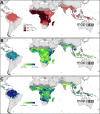A new world malaria map: Plasmodium falciparum endemicity in 2010
- PMID: 22185615
- PMCID: PMC3274487
- DOI: 10.1186/1475-2875-10-378
A new world malaria map: Plasmodium falciparum endemicity in 2010
Abstract
Background: Transmission intensity affects almost all aspects of malaria epidemiology and the impact of malaria on human populations. Maps of transmission intensity are necessary to identify populations at different levels of risk and to evaluate objectively options for disease control. To remain relevant operationally, such maps must be updated frequently. Following the first global effort to map Plasmodium falciparum malaria endemicity in 2007, this paper describes the generation of a new world map for the year 2010. This analysis is extended to provide the first global estimates of two other metrics of transmission intensity for P. falciparum that underpin contemporary questions in malaria control: the entomological inoculation rate (PfEIR) and the basic reproductive number (PfR).
Methods: Annual parasite incidence data for 13,449 administrative units in 43 endemic countries were sourced to define the spatial limits of P. falciparum transmission in 2010 and 22,212 P. falciparum parasite rate (PfPR) surveys were used in a model-based geostatistical (MBG) prediction to create a continuous contemporary surface of malaria endemicity within these limits. A suite of transmission models were developed that link PfPR to PfEIR and PfR and these were fitted to field data. These models were combined with the PfPR map to create new global predictions of PfEIR and PfR. All output maps included measured uncertainty.
Results: An estimated 1.13 and 1.44 billion people worldwide were at risk of unstable and stable P. falciparum malaria, respectively. The majority of the endemic world was predicted with a median PfEIR of less than one and a median PfRc of less than two. Values of either metric exceeding 10 were almost exclusive to Africa. The uncertainty described in both PfEIR and PfR was substantial in regions of intense transmission.
Conclusions: The year 2010 has a particular significance as an evaluation milestone for malaria global health policy. The maps presented here contribute to a rational basis for control and elimination decisions and can serve as a baseline assessment as the global health community looks ahead to the next series of milestones targeted at 2015.
Figures






References
-
- Anonymous. The African Summit on Roll Back Malaria. Roll Back Malaria/World Health Organization; The Abuja Declaration and the Plan of Action: An extract from The African Summit on Roll Back Malaria, Abuja, 25 April 2000 (WHO/CDS/RBM/2000.17) pp. 1–11.
-
- WHO. Global strategic plan. Roll Back Malaria. 2005-2015. Geneva: World Health Organization; 2005.
Publication types
MeSH terms
Grants and funding
LinkOut - more resources
Full Text Sources

